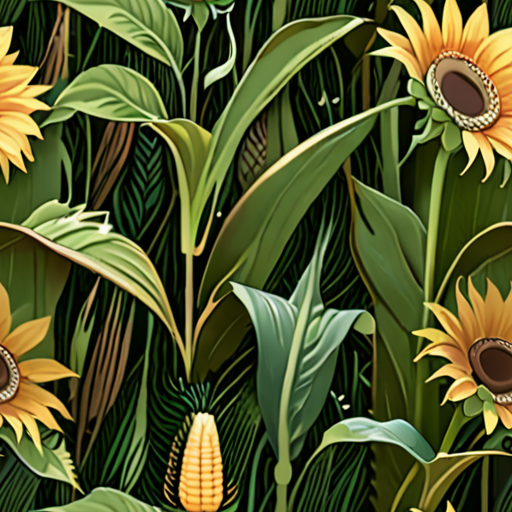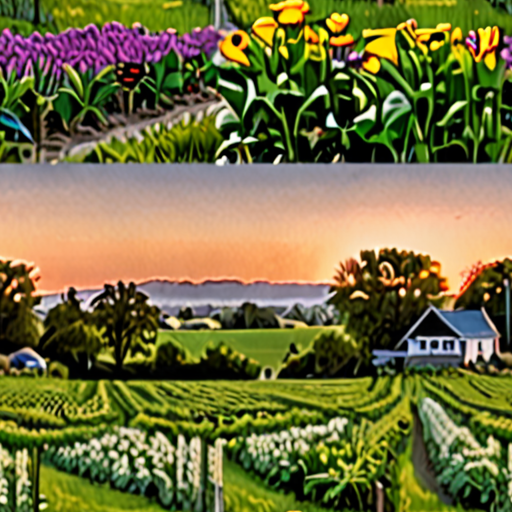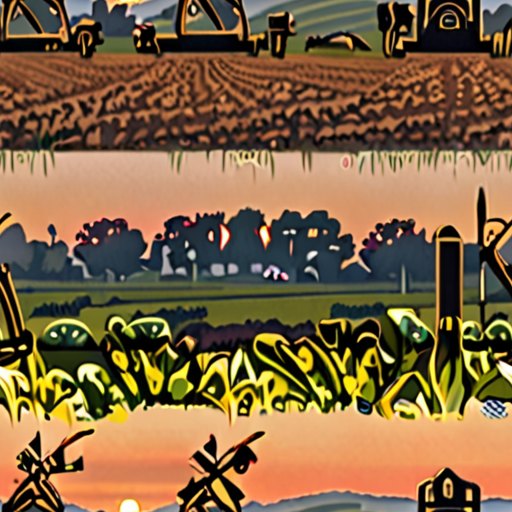As we navigate the complexities of modern agriculture, it’s easy to overlook the significance of preserving traditional crops – those heirloom varieties that have been passed down through generations, shaped by the unique cultural, social, and environmental contexts of their origins.
In many parts of the world, traditional crops continue to play a vital role in maintaining biodiversity, ensuring food security, and promoting local economies.
However, with the increasing adoption of industrialized farming practices, there is a growing concern about the loss of these valuable genetic resources and the knowledge associated with their cultivation.
This raises important questions about the importance of preserving traditional crops in modern agriculture practices, and what steps can be taken to safeguard their future.
By exploring the historical context of crop preservation techniques, examining the differences between traditional and modern farming practices, and highlighting the benefits and drawbacks of each approach, we can gain a deeper understanding of the complex issues surrounding traditional crops and their place in contemporary agriculture.
From the perspectives of farmers, policymakers, and consumers, this discussion aims to shed light on the significance of preserving traditional crops and the potential applications of these crops in modern agriculture.
Ultimately, our goal is to spark a conversation about the importance of preserving cultural heritage and promoting sustainable agriculture practices that prioritize the well-being of people, planet, and prosperity.
Traditional Method of Crop
Crop rotation and mixed intercropping have been practiced for centuries, allowing farmers to optimize land use and promote soil health.
- Mixed intercropping involves growing two or more crops together in the same field, taking advantage of complementary growth habits and pest resistance.
- This approach can increase yields, reduce pests and diseases, and promote biodiversity.
- Examples of successful mixed intercropping systems include the “Three Sisters” method, where corn, beans, and squash are grown together.
In addition to mixed intercropping, crop rotation is another essential component of traditional cropping systems.
- Crop rotation involves rotating different crops through the same field to break disease and pest cycles.
- This approach can improve soil fertility, structure, and overall health.
- For example, planting legumes followed by cereals can fix nitrogen in the soil and improve its fertility.
Old Seed promotes these traditional methods through our resources and guides, helping gardeners and farmers adopt environmentally friendly practices.
We encourage readers to explore our website for more information on sustainable agriculture and heirloom gardening.
Other notable organizations, such as Permaculture Association and Biodynamic Farming and Gardening Association , offer valuable insights and resources on regenerative agriculture and organic farming practices.
By adopting these traditional methods, we can work towards a more sustainable food system and preserve agricultural heritage for future generations.
Old Farming Practices
In ancient civilizations such as Mesopotamia, Egypt, and China, farming techniques were rudimentary but effective.
- Farmers used simple tools like wooden plows and sickles to till the land and harvest crops.
- They relied on natural fertilizers like animal manure and crop rotation to maintain soil fertility.
- The earliest evidence of farming dates back to around 10,000 years ago during the Neolithic era.
- During this time, people began to domesticate plants and animals, leading to the development of settled agriculture.
- This marked a significant shift from nomadic hunter-gatherer lifestyles to more sedentary communities.
As societies grew and became more complex, farming practices evolved to meet the needs of increasing populations.
- The invention of the wheel around 4000 BCE revolutionized transportation and trade, allowing for the widespread distribution of goods and ideas.
- The development of iron tools during the Bronze Age enabled farmers to till the land more efficiently and plant crops on a larger scale.
- Crop rotation and irrigation systems became more sophisticated, allowing farmers to grow a wider variety of crops and increase yields.
- The use of draft animals like oxen and horses further increased productivity and allowed for the cultivation of heavier soils.
These advancements in farming technology and techniques played a crucial role in shaping human history and enabling the growth of complex societies.
Traditional Farming Methods
Many traditional farming methods have been passed down through generations and continue to be practiced today.
- Organic farming relies on natural methods to control pests and diseases, rather than synthetic chemicals.
- Permaculture aims to create sustainable and self-sufficient ecosystems by mimicking nature’s patterns and relationships.
- Biodynamic farming focuses on the spiritual and holistic aspects of farming, seeking to create a balanced and healthy environment.
- Sustainable agriculture prioritizes environmental stewardship and social responsibility, often incorporating practices like agroforestry and regenerative agriculture.
By embracing these traditional methods, modern farmers can reduce their environmental impact, promote biodiversity, and produce healthier food for consumers.
Heirloom Seeds and Sustainable Agriculture
At Old Seed, we believe in preserving heirloom seeds and promoting sustainable agriculture practices.
We offer a wide selection of heirloom seeds, carefully curated to preserve genetic diversity and promote ecological balance.
Our community-driven approach encourages collaboration and knowledge-sharing among farmers, helping to build a more resilient and sustainable food system.
Join us in our mission to cultivate a greener future and promote environmentally conscious farming practices.
Traditional Farming vs Sustainable Farming
Sustainable farming is often compared to traditional farming, which focuses on maximizing yields and profits through intensive farming practices.
- Difference in Approach: Traditional farming prioritizes efficiency and uniformity, whereas sustainable farming emphasizes diversity, interconnectedness, and preservation.
- Plant and Animal Diversity: Sustainable farming involves growing a variety of crops and raising diverse animal species, which helps maintain soil health and promotes biodiversity.
- No Synthetic Fertilizers: Sustainable farming avoids the use of synthetic fertilizers and pesticides, opting for organic alternatives that promote healthy soil ecosystems.
- Water Conservation: Sustainable farming practices water conservation techniques, reducing waste and minimizing the impact on local water sources.
- Soil Erosion Prevention: Sustainable farming employs techniques like crop rotation and cover cropping to prevent soil erosion and maintain soil fertility.
- Supports Local Communities: Sustainable farming often supports local communities by providing fresh produce and promoting economic growth.
- Long-Term Sustainability: Sustainable farming prioritizes long-term sustainability over short-term gains, recognizing the importance of preserving natural resources for future generations.
As a gardener and advocate for sustainable agriculture, I believe that adopting these practices can have a significant positive impact on our environment and communities.
For more information on sustainable gardening practices and heirloom seed preservation, visit our Heirloom Seeds page.
Additionally, learn more about the benefits of sustainable agriculture and how to get started with your own sustainable garden on our Sustainable Gardening Tips page.
By choosing sustainable farming practices, we can work towards a more environmentally conscious and resilient food system.
Traditional Agriculture
Traditional agriculture refers to the practice of cultivating crops and raising livestock using methods passed down through generations.
-
Heirloom Gardening
Heirloom gardening involves growing plants that have been saved and handed down through families and communities.
- Crops are often grown using open-pollination methods, which allow for genetic diversity and adaptation to local conditions.
- Heirloom varieties can offer unique flavors, textures, and colors, making them a valuable part of a diverse diet.
-
Sustainable Practices
Sustainable agriculture focuses on minimizing harm to the environment while producing food.
- This approach may involve using organic amendments, conserving water, and reducing waste.
- Sustainable farming practices can help maintain soil health, support biodiversity, and promote ecosystem services.
-
Preserving Agricultural Traditions
Preserving agricultural traditions involves documenting and sharing knowledge about crop selection, planting, and harvesting methods.
- This can include learning from experienced farmers, participating in community-supported agriculture programs, and preserving heirloom seeds.
- Agricultural traditions can provide a sense of connection to the land and community, while also promoting cultural heritage.
By embracing traditional agriculture, we can work towards a more sustainable food system that values the importance of local knowledge and community involvement.
Key Principles of Traditional Agriculture
-
Soil Conservation
Traditional agriculture emphasizes the importance of maintaining healthy soils through practices like crop rotation, composting, and cover cropping.
-
Biodiversity
Diverse ecosystems are essential for supporting a wide range of plant and animal species, which in turn contribute to ecosystem resilience and productivity.
-
Local Food Systems
Traditional agriculture promotes the idea of consuming locally produced foods, which reduces transportation costs and supports local economies.
-
Community Involvement
Farming is often a communal activity, with neighbors working together to share knowledge, tools, and labor.
By adopting these principles, we can create a more equitable and sustainable food system that benefits both people and the planet.
Two Downfalls of Traditional Farming
As someone who values sustainable living and environmentally conscious practices, I’ve come to realize that traditional farming has its drawbacks.
- Soil Degradation
- Water Pollution
One major issue with traditional farming is the degradation of soil quality. Intensive farming practices can lead to soil erosion, nutrient depletion, and reduced fertility, making it difficult to sustain crop yields in the long run.
This is because traditional farming often relies heavily on chemical fertilizers and pesticides, which can harm beneficial microorganisms in the soil and disrupt the delicate balance of ecosystems.
To mitigate this issue, many farmers are turning to regenerative agriculture practices that promote soil health through techniques like cover cropping, crop rotation, and minimal tillage.
Another significant drawback of traditional farming is the impact it has on water quality. Excess fertilizer runoff from farms can pollute nearby waterways, harming aquatic life and human health.
This is particularly concerning in areas where water scarcity is already a pressing issue, as polluted water sources can exacerbate these problems.
By adopting more sustainable farming practices, we can reduce the risk of water pollution and protect our planet’s precious water resources.
At Old Seed , we’re committed to promoting environmentally friendly farming practices that benefit both people and the planet.
Types of Traditional Methods of Agriculture
Traditional methods of agriculture refer to various practices that have been passed down through generations, often relying on manual labor, simple tools, and minimal external inputs.
-
Shifting Cultivation
This method involves clearing a plot of land, planting crops, and then moving to a new area once the soil becomes depleted. Shifting cultivation is commonly practiced in tropical regions where the climate is warm and rainfall is abundant.
-
Slash-and-Burn Agriculture
A variation of shifting cultivation, slash-and-burn involves cutting down trees and burning the vegetation to clear the land. This method is often used in conjunction with crop rotation to maintain soil fertility.
-
Subsistence Farming
Subsistence farming focuses on producing enough food for a family’s immediate needs, rather than generating surplus for sale. This method is often practiced in small-scale farming communities where access to markets may be limited.
-
Intercropping
Intercropping involves growing multiple crops together in the same field, often to maximize space and reduce pests and diseases. This method is commonly used in traditional farming systems where crop diversity is valued.
-
Crop Rotation
Crop rotation involves alternating between different crops to maintain soil fertility, control pests and diseases, and promote biodiversity. This method is essential for maintaining healthy soils and reducing the need for external fertilizers and pesticides.
-
Green Manure
Green manure involves incorporating legumes or other nitrogen-fixing plants into the soil to enhance its fertility. This method is often used in combination with crop rotation to maintain soil health.
-
Organic Amendments
Organic amendments involve using natural materials such as compost, manure, or green waste to enrich the soil. This method is preferred over synthetic fertilizers, which can harm the environment and human health.
In addition to these methods, traditional farmers often rely on local knowledge and observation to inform their decision-making. By working with nature and respecting the limitations of their environment, traditional farmers can maintain productive and sustainable agricultural systems.
Conclusion
The types of traditional methods of agriculture listed above offer valuable insights into the diverse approaches used by farmers around the world. By understanding and appreciating these methods, we can work towards developing more sustainable and resilient agricultural systems that benefit both people and the planet.





0 Comments